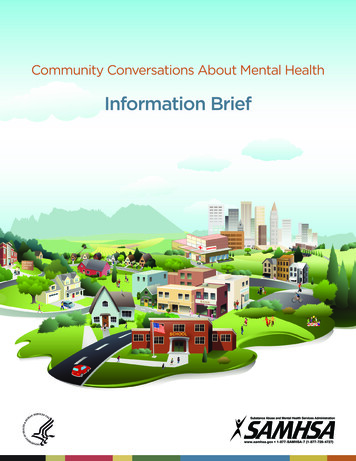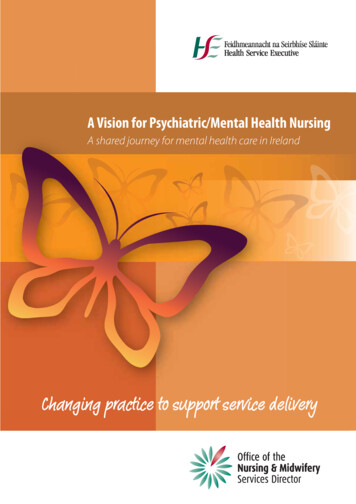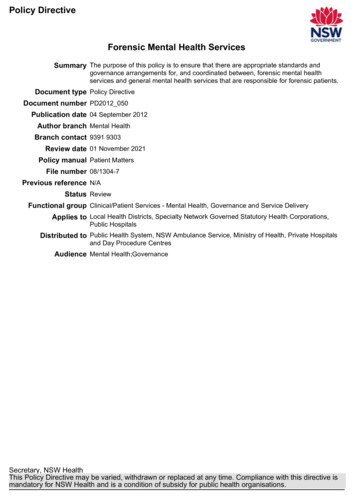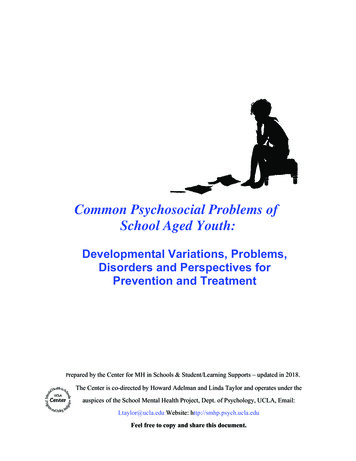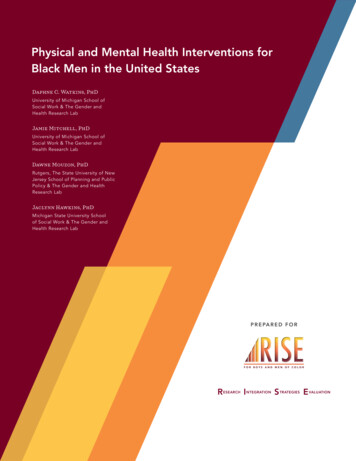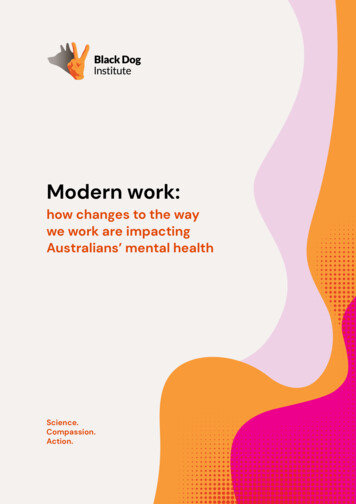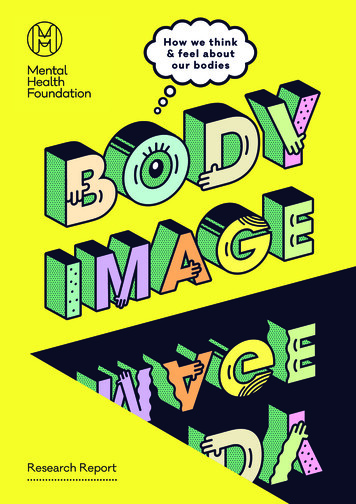
Transcription
Research Report
1.FOREWORDAt the Mental Health Foundation,we are all about public health andprevention. We focus on bringingevidence into action that makes a real impacton people’s lives.This year’s theme for Mental Health AwarenessWeek is body image. It is a subject that has adirect relevance to all of us. We are all learningto live with the wonders and limitations of ourbodies as they change through life. No pieceof technology that we will ever buy will matchthe complexity, sophistication and regenerativepowers of our bodies.And yet, for too many of us, our bodies aresources of shame and distress.Last year, our survey of respondents who hadexperienced high levels of stress revealed that47% of 18-24-year-olds, 36% of all women, andalmost one in five people (18%) aged 55 hadexperienced stress over their body image tothe extent of being overwhelmed and unable tocope in the last year. It was clearly an issue thatneeded more attention. This year’s report buildson the latest published research with one of thelargest surveys ever completed to capture howwe feel about our bodies.The report sets out the individual, family andcultural influences that are coming togetherto mean that we often have a gnawing anddebilitating sense of dissatisfaction with ourown bodies. We also identify the heightenedrisks of mental health problems that too oftenaccompany poor body image.There is a long tradition of Western philosopherswho have shaped how we think about ourbodies as different and separate from our mind.But the evidence has led us to question thisform of dualism and instead embrace a holisticunderstanding about the inter-relatedness ofour bodies and minds. This is vital to achievea healthier population. And we are now clearthat cultures that are focused on materialism,consumption and celebrity lifestyles fare worseboth in terms of people’s body image andmental health.So, we make the case that the distress relatedto poor body image and the related mentalhealth problems can be prevented. This reportis clear that changes to culture, parentingstyles, schooling approaches, use of technology,advertising standards and how we addressdiscrimination will make a real difference.We are not publishing this report simply forinformation. We are calling for action acrossall levels of society, which, if heeded, will helpus to be kinder to our bodies and healthier inour minds.Mark Rowland, Chief ExecutiveMental Health Foundation
BODY IMAGE: HOW WE THINK AND FEEL ABOUT OUR BODIES2.EXECUTIVESUMMARY‘Body image’ is a term that can beused to describe how we think andfeel about our bodies. Our thoughtsand feelings about our bodies can impact usthroughout our lives, affecting, more generally,the way we feel about ourselves and our mentalhealth and wellbeing. Having body imageconcerns is a relatively common experienceand is not a mental health problem in and ofitself; however, it can be a risk factor for mentalhealth problems. Research has found thathigher body dissatisfaction is associated witha poorer quality of life, psychological distressand the risk of unhealthy eating behaviours andeating disorders. Conversely, body satisfactionand appreciation has been linked to betteroverall wellbeing and fewer unhealthy dietingbehaviours. Though feeling unsatisfied with ourbodies and appearance is often more commonamong young women, body image concerns arerelevant from childhood through to later life andaffect both women and men.The way in which our experiences andenvironment affect our body image will bedifferent for everyone. However, overall, theresearch suggests that body image can beinfluenced by our relationships with our familyand friends; how our family and peers feel andspeak about bodies and appearance; exposureto images of idealised or unrealistic bodiesthrough media or social media; and pressure tolook a certain way or to match an ‘ideal’ bodytype. There are further issues relevant to bodyimage and mental health that are specific tocertain factors and experiences, such as longterm health conditions, cultural differencesaround body ideals, and gender and sexuality,which are often linked to other societal factorsand discrimination.New online surveys were conducted by the Mental Health Foundation with YouGov in March2019 of 4,505 UK adults 18 and 1,118 GB teenagers (aged 13-19). The results highlighted that:ADULTSOne in five adults (20%)felt shame, just over onethird (34%) felt down orlow, and 19% felt disgustedbecause of their bodyimage in the last year.20 %Felt shame34 %Felt down or low19 %Felt disgusted
EXECUTIVE SUMMARY3.TEENAGERSAmong teenagers, 37%felt upset, and 31% feltashamed in relation totheir body image37%Felt upset31%Felt ashamedADULTSJust over one third of adults saidthey had ever felt anxious (34%) ordepressed (35%) because of theirbody image, and one in eight (13%)experienced suicidal thoughts orfeelings because of concerns abouttheir body image.ADVERTISINGJust over one infive adults (21%)said images usedin advertising hadcaused them toworry about theirbody image.34 %Felt anxiousNEW!35 %Felt depressedExperienced suicidalthoughts or feelingsSOCIAL MEDIAJust over one in fiveadults (22%) and40% of teenagerssaid images on socialmedia caused themto worry about theirbody image.Clearly action is needed to build and promote positive body imageand support good mental health and wellbeing in relation to ourbodies. Everyone has a right to feel comfortable and confident intheir own bodies and our report highlights key recommendations for:The need forcommitment from socialmedia companies to playa key role in promotingbody kindness.13 %Taking a public healthapproach to body image bytraining frontline health andeducation staff.Effective regulationof how body imageis portrayed.Individually being moreaware of how we can takecare of ourselves and othersin relation to body image.
BODY IMAGE: HOW WE THINK AND FEEL ABOUT OUR BODIESSUMMARY FREC MMEN DATI NSEffective regulation of how body image is portrayedThe Online Harms White Paper should address harms relating to the promotion ofunhelpful or idealised body image online, beyond content related to eating disorders.An improved practice on how social media platforms promote unhealthy imagingshould be enforced by the new independent regulator.The Advertising Standards Authority should consider pre-vetting high-reach broadcastadverts from high-risk industries – such as cosmetic surgery companies and weight-lossproducts and services – to ensure all advertising abides by its codes. It should also makegreater use of its ability to proactively instigate investigations.Industry responsibility to promote body kindnessSocial media companies should sign the Be Real Campaign’s Body Image Pledge andinvestigate new ways of using their platforms to promote positive body image and toensure that a diversity of body types is presented positively to their users.Social media companies should have clear systems for users to report bullying anddiscrimination and targets for action to be taken. They should give users greater controlover the content they see in an accessible way.4.
SUMMARY OF RECOMMENDATIONS5.Public health and education approaches to body imageTraining for frontline health practitioners and the early years childcare workforce shouldinclude information about how parents and carers can, from a very early age, positivelyinfluence their children’s feelings about their bodies through their behaviours andattitudes.Children and adults in distress should receive fast and empathetic support when theyneed it, regardless of where they live in the country.Public campaigns on nutrition and obesity should avoid the potential to create stigma andindirectly contribute to appearance-based bullying. They should focus on healthy eatingand exercise for all members of the population, regardless of weight.A co-produced body image and media literacy toolkit should be a compulsory elementof what children learn in schools. This should include the development of a charter forachieving a healthy and positive body image.Individually being more aware of steps we can take forourselves and othersIf your body image is a significant cause of stress, or if you’re being bullied about how yourbody looks, consider talking to a friend, a trusted adult or a health professional.Spring-clean your apps on your smartphone.Notice the people and accounts you’re following on social media and be mindful of howyou feel about your own body and appearance when you look at them.If you see an advert in a magazine, on television or online that you think presents anunhealthy body image as aspirational, you can complain to the Advertising StandardsAuthority.At home, parents and carers can lead by example, by modelling positive behaviour aroundbody image, eating healthily and staying active.In our daily lives, we can all be more aware of the ways in which we speak about our ownand other people’s bodies in casual conversations with friends and family.Find the best way that works for you to stay active.
BODY IMAGE: HOW WE THINK AND FEEL ABOUT OUR BODIES6.INTRODUCTIONWhat is body image?‘Body image’ is a term that can be usedto describe how we think and feelabout our bodies.opinions about our appearance affect ourfeelings about ourselves (1–4).Because these thoughts and feelings can becomplex, approaches to define and understandOften, when we talk about ‘poor body image’,we are referring to a feeling of being unsatisfiedwith our body – either because of appearance,body image are varied and can include: howwe view our bodies and how accurate thisperception is; how satisfied we are with ourbodies and appearance; how we experienceour bodies in our environment; how much wevalue what other people think about our bodiesand appearance; and how much other people’sor the way it functions. This is described as ‘bodydissatisfaction’. In contrast, positive body imagecan be described as being satisfied with our body,holding respect, appreciation and acceptance ofits abilities, and having a healthy balance betweenvaluing our body and valuing the other aspects ofourselves that make us ‘us’ (2,3,5).How comfortable are we with our bodies?Feeling unhappy with our appearance isa relatively common experience. TheMental Health Foundation conducted asurvey with YouGov in March 2019 of 4,505UK adults. Our survey found that while 21%of adults felt ‘satisfied’ because of their bodyimage, in the past year, one in five people (20%)have felt ‘shame’ and just over one third (34%)have felt ‘down or low’ in the past year becauseof their body image. Our survey suggestshigher numbers compared to the 2013 BritishSocial Attitudes Survey, where one in twentymen and one in ten women reported beingdissatisfied with their appearance (6).Body image and appreciation is relevantacross our lives from youth through to laterlife. The proportion of women in the BritishSocial Attitudes Survey saying they weresatisfied with their appearance was similaramong those aged 18–34 and those over65 (6). This was similar in our survey, where30% of adults aged 18–24 reported feeling‘satisfied’ because of their body image inthe last year, compared to 24% of adultsaged 55 .While women and girls are often more likelyto report being unsatisfied with their bodies,men and boys are also affected by bodyimage concerns. A survey in 2016 foundthat 10% of secondary school boys have saidthey skipped a meal to change how they lookand 10% would consider taking steroids toachieve their goals (7).
INTRODUCTIONAs a society, we tend to place a great deal ofimportance on our appearance. Nearly halfof adults (47%) in the British Social AttitudesSurvey felt that ‘how you look affects whatyou can achieve in life’ and nearly onethird (32%) felt that ‘your value as a person7.depends on how you look’ (6). Therefore,how we think and feel about our bodies issomething that can affect us throughout ourlives and has far-reaching implications for ourfeelings about ourselves, and on our mentalhealth and wellbeing.How does body image link to mental health?Having body image concerns is not amental health problem in and of itself;however, it can be a risk factor formental health problems. Research has foundthat higher body dissatisfaction is associatedwith a poorer quality of life and psychologicaldistress (8), a higher likelihood of depressionsymptoms (9,10) and the risk of unhealthyeating behaviours and eating disorders (10,11).Conversely, body satisfaction and appreciationhave been linked to better overall wellbeing (12)and fewer unhealthy dieting behaviours (5,13).This is reflected in our survey, where justover one third of adults said they felt anxious(34%) or depressed (35%) because of theirbody image, and just over one in eight (13%)experienced suicidal thoughts or feelingsbecause of concerns about their body image.In a second new survey conducted by theMental Health Foundation with YouGov inMarch 2019 of 1,118 GB teenagers aged 13–19, 40% felt worried, 37% felt upset, and 31%felt ashamed in relation to their body image.Body image is closely linked to mentalhealth problems such as body dysmorphicdisorder (BDD) and eating disorders likeanorexia and bulimia. BDD is a mental healthproblem where a person spends a lot of timeworrying about flaws in their appearancethat are often unnoticeable to others, tothe point that it affects their daily life (14).Poor body image is both a risk factor for,and part of the diagnostic criteria of, theseconditions (11). There is extensive researchon the role body image plays in eatingdisorders, and body dysmorphia, and theways in which these conditions can bestbe treated and prevented. In the currentreport, we focus on body image concerns ingeneral, rather than specifically in relationto eating disorders or BDD. A review ofthe literature on eating disorders or BDDtreatment is therefore beyond the scopeof this report, but resources for furtherreading in this area can be found on the NHSinformation pages for body dysmorphicdisorder and eating disorders, as well asfrom voluntary organisations such as Beat,Anorexia & Bulimia Care and YoungMinds.More information on the recommendedguidance for treatment of eating disordersand body dysmorphic disorder can be foundin the National Institute for Health and CareExcellence (NICE) guidelines.It is important to note that body imageresearch often looks at the characteristicsof a group of people at a single point intime. This can make it hard to be surewhich factors cause either poor bodyimage or common mental health problems.For example, feeling dissatisfied with yourbody may cause you to feel depressed, orit may be that you are more likely to feeldissatisfied with your body if you are alreadyexperiencing depression. The researchthat does look at these changes over time
BODY IMAGE: HOW WE THINK AND FEEL ABOUT OUR BODIESsuggests it may be a combination of the two,and that sometimes body dissatisfaction maypredict or otherwise affect the development8.of depression or anxiety symptoms (15,16)and in other contexts, symptoms may predictbody dissatisfaction (15,17).What affects body image?The way in which our experiences andenvironment affect our body imagewill be different for everyone. Overall,however, the research suggests that bodyimage may be influenced by our relationshipswith our family and friends (18); how ourfamily and peers feel and speak about bodiesand appearance (19); exposure to images of‘idealised’ or unrealistic bodies through themedia or social media (1,20,21); and pressure tolook a certain way or to match an ‘ideal’ bodytype (21).Valuing and holding oneself against anunrealistic, ‘ideal’ body type is often referred toin the research as ‘internalisation of the ideal’and is commonly linked to the development ofpoor body image through feelings of shame ordistress when this ideal is not met (21). Whatthis ideal looks like will shift across culturesand can vary between genders. In Westerncultures, it is common for the ‘ideal’ for womento be thin body shapes, but with maintainedcurves (referred to as the ‘thin ideal’), while formen the ‘ideals’ are being taller and having amuscular body shape.From a therapeutic perspective, ‘internalisationof the ideal’ can be understood as part of aprocess of internalising a shamed body image.Shame is an emotion that we are all bornwith the capacity to feel, and which, in itshealthy form, can be adaptive, as it promptsus to attend to ruptures in our relationshipswith others by making amends and repairinginterpersonal connections. In contrast,unhealthy shame is the feeling of being apartor isolated from others due to a sense of beinginadequate, defective or not good enough(22). Body shame can become internalisedand unhealthy when we experience consistentshaming messages about our bodies eitherdirectly (through criticism, teasing or bullying)or more indirectly (by being excluded oravoided, or consistently exposed to nonthoughtful language or unrealistic images of‘ideal bodies’). Once internalised, this sense ofshame operates regardless of how our bodiesactually look or function.All of this suggests that body image is acomplex, and often very personal, experience.Its relationship to mental health is animportant one, influenced by many aspects ofour environment that shift and change acrossour lives.
BODY IMAGE IN CHILDHOOD9.B DY IMAGE INCHILDHDHow comfortable are children and young people withtheir bodies?While exact estimates vary, dependingon how body image is measured,concern and worries aboutappearance are commonplace among youngpeople. One survey of 11–16-year-olds in theUK by Be Real found that 79% said how theylook is important to them, and over half (52%)often worry about how they look (23). In oursurvey of young people aged 13–19, 35% saidtheir body image causes them to ‘often’ or‘always’ worry.While body image concerns affect both boysand girls, there is research to suggest that girlsare more likely to be dissatisfied with theirappearance and their weight than boys (24,25).In our survey, 46% of girls reported that theirbody image causes them to worry ‘often’or ‘always’ compared to 25% of boys. Bodyimage concerns can also affect very youngchildren. One review found studies identifyingbody dissatisfaction in children under theage of six, though estimates of the degree ofdissatisfaction varied widely depending on howit was measured (26).Young people also tell us that body image isa substantial concern, with 16–25-year-oldsidentifying it as the third biggest challengecurrently causing harm to young people, withlack of employment opportunities and failureto succeed within the education system beingthe first two (27).How does body image affect children and young people?In young people, body dissatisfaction hasbeen linked to risk-taking behaviours andmental health problems. One survey of UKadolescents by Be Real found that 36% agreedthey would do ‘whatever it took’ to look good,with 57% saying they had considered going ona diet, and 10% saying they had consideredcosmetic surgery (23). Among secondaryschool boys, 10% said they would considertaking steroids to achieve their goals (7).Poor body image may also prevent youngpeople from engaging in healthy behaviours,with some studies finding that children withpoorer body image are less likely to take partin physical activity (5,28) and survey data fromBe Real finding that 36% of girls and 24% ofboys report avoiding taking part in activities
BODY IMAGE: HOW WE THINK AND FEEL ABOUT OUR BODIESlike physical education due to worries abouttheir appearance (23). Among adolescents,research has found that those with greaterbody appreciation are less likely to diet or usealcohol or cigarettes (5).Body dissatisfaction and a pressure to be thinhave been linked to depressive symptoms(15, 29) and symptoms of anxiety disorderssuch as social anxiety or panic disorder (16),particularly in those children who do not matchsocietal views of the ‘ideal body’. Some studieshave found that weight and body mass index(BMI) are correlated with body dissatisfaction,10.with youth people who are overweight or obesereporting greater depressive symptoms andlower self-esteem than their peers (30,31).Research conducted with young women alsofound a higher likelihood of suicidal thoughtsamong those women who reported extremeweight control behaviours (e.g. taking diet pills,diuretics or laxatives) (32), with an additionalstudy suggesting that body image concernsmay be a risk factor for self-harm behaviouramong young people who are experiencingemotional difficulties (33).What affects body image in childhood?Body ideal internalisationne common contributor to poor bodyimage is feeling a pressure to live upto an ‘ideal’ body type or appearanceand feeling shame or other uncomfortableemotions when we perceive ourselves as notmeeting this standard. Internalisation of thisideal has been linked to body dissatisfactionand disordered eating and depressivesymptoms in children and young people (19, 34,35). These distressing emotions were reflectedin our survey, where 37% of young people saidthey felt upset, and 31% said they felt ashamedin relation to their body image.This ideal tends to be different betweengenders. Young women often report feeling apressure to be thin, but to still maintain curves,whereas young men often report pressureto be tall and muscular (19,23). Children whorejected appearance-related ideals reportedbeing more confident about their appearanceand were least likely to report body imageconcerns (23).How young people develop their sense of‘ideal’ appearance is varied, but young peoplethemselves identify the media, pressure fromfamily and friends, comparisons with peers, andpersonal factors like low self-esteem, feelingsof depression, and a need for control asimportant influences on their own body image(36,37).The media and social mediane commonly researched influenceon body image is exposure tounrealistic ‘ideal’ bodies through film,television, magazines, advertising and socialmedia. Exposure to these images is thoughtto facilitate the valuing of these ‘ideal’ andunrealistic body types. One study, whichfollowed 14- and 15-year-olds over three years,found that internalisation of these ‘ideal’ bodyshapes as presented in the media predictednegative emotions about appearance, whichin turn predicted unhealthy eating behaviours(34). In our survey, 25% of young people (13%of boys and 37% of girls) said celebrities havecaused them to worry in relation to their bodyimage, and 19% (10% of boys and 28% of girls)said TV shows caused them to worry in relationto their body image.
BODY IMAGE IN CHILDHOODUsing more social media has also been linkedto children and young people feeling lesssatisfied with their bodies (38,39). In oursurvey, 40% of young people (26% of boysand 54% of girls) said that images on socialmedia have caused them to worry in relationto their body image. One possible explanationfor this is that social media allows for negativecomparisons with others based on appearance.This is something that has consistently beenlinked to body dissatisfaction (40). There aresome studies that suggest time spent on socialmedia is linked to frequency of appearancerelated comparisons (41) and peer competition(42), which in turn may be linked to bodydissatisfaction and mental health (41,42).Parents and family membersThe influence of the media on bodyimage may be lessened by parentalbehaviour. One study found that therelationship between social media use andbody dissatisfaction was weaker for thoseadolescents that had more positive maternalrelationships (38), and another found thatthe children of parents who reported greatercontrol over time spent on social mediareported spending less time online, makingfewer appearance-related comparisons, andhaving better overall mental health (41).Parents and family can also have a negativeeffect on children’s body image and increasethe likelihood of difficulties in this area. Onestudy of adolescent girls found that over halfhad experienced weight-based teasing fromfamily members, particularly girls who weighedmore, and these experiences were relatedto higher levels of body dissatisfaction andunhealthy eating behaviour (43). This was alsoreflected in our survey, where 29% of youngpeople (21% of boys and 37% of girls) agreedthat things their family said have caused themto worry in relation to their body image. This11.extends to the way that parents think, act andspeak about their own bodies as well as theirchildren’s bodies. Reviews of the researchsuggest that parents can affect their children’sbody image in both direct ways (comments orcriticisms about weight and appearance) andmore indirect ways (parental eating behaviours,and attitudes toward their own bodies andappearance) (19,44).PeersAs children grow older, their peers beginto play more of a role in reinforcingwhat an ideal body looks like. Thiscan be through pressure from friends to feelaccepted. In our survey, 40% of young people(37% of boys and 42% of girls) agreed thatthings their friends have said have causedthem to worry in relation to their body image.Another survey found that 68% of boys citedfriends as a source of pressure to look good (7).The ways in which adolescents’ bodies changeduring puberty (a time of change in bodyheight, weight and shape), how this compareswith their peers, and how it compares to theirown ideas of what an ‘ideal’ body looks like(which, in turn, can be influenced by the factorsoutlined above) will therefore affect bodyimage (45). This may especially be the case forgirls who mature earlier than their peers, andboys who mature later than their peers (45).The influence of peers can also be feltthrough bullying. A survey by Be Real of UK11–16-year-olds found that over half of youngpeople had experienced appearance-basedbullying, with 40% of those young peopleexperiencing bullying at least once a week,and 54% saying the bullying had started byage 10 (46). Children who do not match bodyideals may be more likely to be the target ofbullying. One review of the research foundthat young people who are overweight or
BODY IMAGE: HOW WE THINK AND FEEL ABOUT OUR BODIESobese are more likely to be subject to bullyingthan their peers (47).Appearance-based bullying can be detrimentalto children’s mental health and body image.Adolescents who were cyberbullied were twiceas likely to consider themselves ‘too fat’ (25)and, of those who were bullied about theirappearance, 53% felt anxious and 29% feltdepressed (46). In contrast, having supportivefriendships may be a protective influence.12.Some studies have found support for strongfriendships being associated with decreasedbody dissatisfaction (25,48,49). However,children who are already feeling down abouttheir bodies may perceive their peers as havinga greater influence (50), particularly as selfesteem and body image are closely linked(24,51).BODY IMAGE INADULTHDHow comfortable are adults with their bodies?ur survey found that while 21% ofadults (23% of men and 19% ofwomen) felt satisfied because oftheir body image in the last year, 20% (15%of men and 25% of women) felt shame, 34%(25% of men and 43% of women) felt down orlow, and 19% (12% of men and 26% of women)felt disgusted in the last year because of theirbody image. Estimates from the British SocialAttitudes Survey suggest that one in twentymen and one in ten women reported beingdissatisfied with their appearance (6). Forpressures around weight and shape specifically,this may be slowly changing. A review of datafrom multiple studies taking place across 30years found evidence for body dissatisfactionrelated to a desire to be thin decreasing slightlyand gradually over time among women andgirls. When looking at body dissatisfactionrelated to a desire to be muscular, however,rates among men and boys as well as womenand girls stayed consistent over time (52).How does body image affect adults?As in childhood and adolescence,increased body dissatisfaction inadulthood has been linked to increasedlikelihood of depressive symptoms (9,10,53),psychological distress (8) and disordered eatingand eating disorders (10,11,54). Positive bodyimage in adulthood has been linked to betteroverall wellbeing and quality of life (8,12,55).This is reflected in our survey, where 34%
BODY IMAGE IN ADULTHOODof adults (28% of men and 40% of women)said they felt anxious and 35% said they feltdepressed (25% of men and 45% of women)because of their body image. Just over onein eight (13% overall – 11% of men and 15%of women) experienced suicidal thoughtsor feelings because of concerns about theirbody image.13.cosmetic surgery, fillers or Botox in the lastyear because of their body image.In our survey, body image was associatedwith a desire to change physical appearance:7% of adults (4% of men and 9% of women)said they had edited photos of themselvesin the last year to change the shape of theirface or body because of their body image.Furthermore, 8% of adults (4% of men andBody image in adulthood may also affectrelationships and sexual wellbeing. There issome research to suggest that greater bodysatisfaction is linked to more positive sexualexperiences, particularly for women (56). Bycontrast, body image concerns can raise selfconsciousness, which can impact negativelyon sexual experiences and responses (57). Inour survey, one in five adults (20%) said theirsex life has been negatively affected by theirbody image in the past year, and 15% said theirrelationship with a partner or spouse had beennegatively affected by their body image in the13% of women) said they had consideredpast year.What affects body image in adulthood?As in childhood, the factors associatedwith body image in adulthood arevaried and linked to the degree towhich ideas about ‘ideal’ body types have beeninternalised, as well as how likely individualsare to compare themselves to others based onappearance.The media and social mediaExposure to idealised imag
body image. NEW! Just over one in five adults (22%) and 40% of teenagers said images on social media caused them to worry about their body image. Effective regulation of how body image is portrayed. The need for commitment from social media companies to play a key role in promoting body kindness. Taking a



